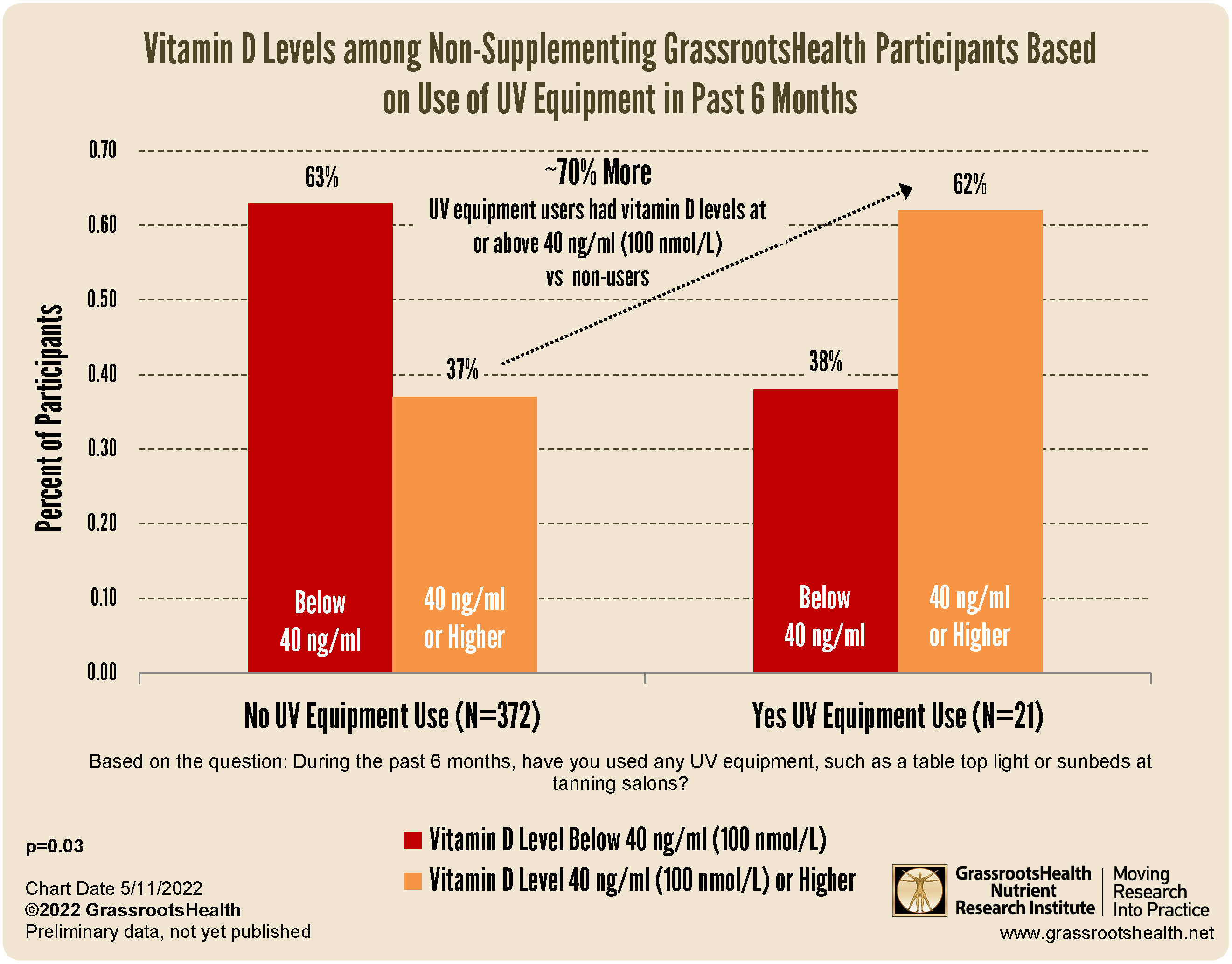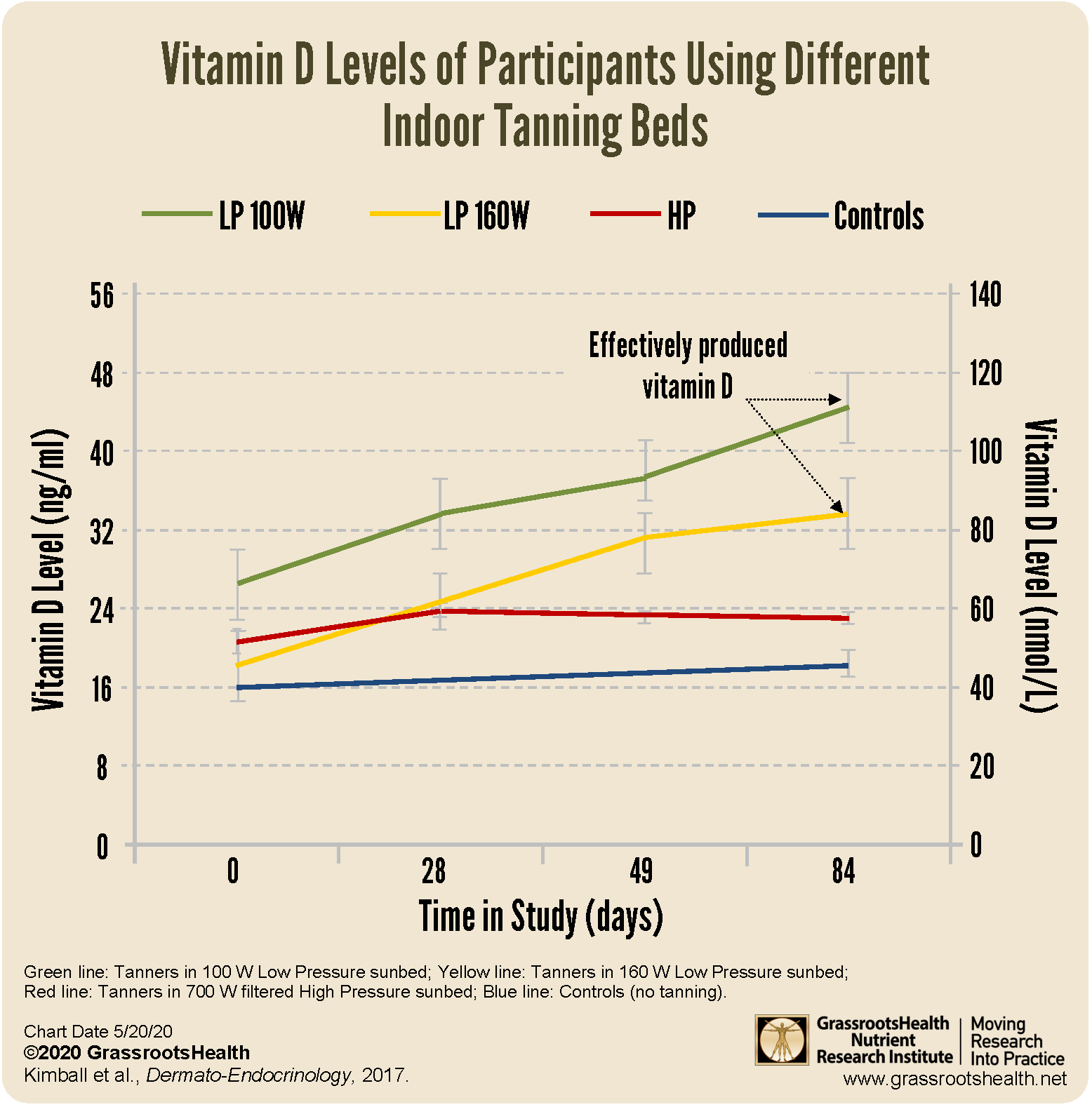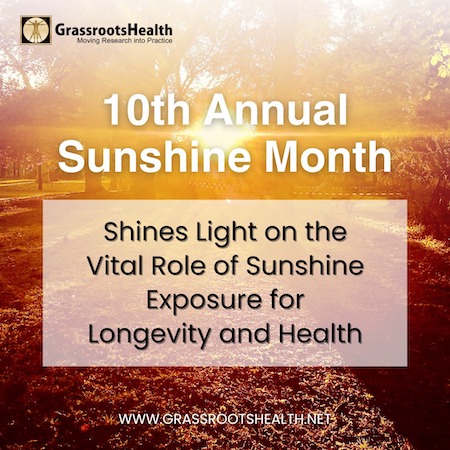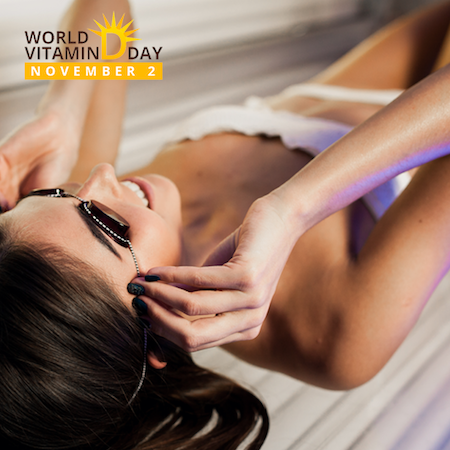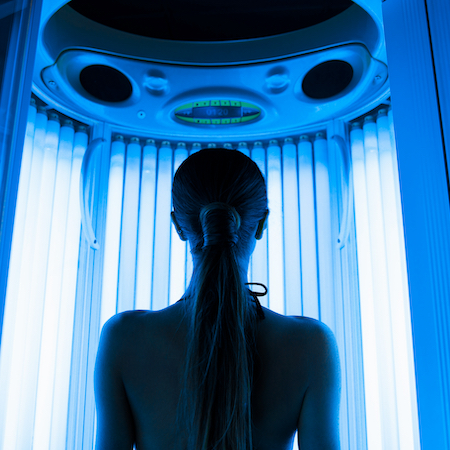Indoor UV devices are artificial sunlight options that can provide a wide spectrum of sunshine health benefits from UVA, UVB, visible light, red light and infrared waves
Key Points
- If outdoor sunshine in any amount is not an option, or if you are unable to get as much exposure to sunlight as you would like, choosing an indoor UV device that produces a wider spectrum of light and energy might be a better choice and could act as your ‘sunshine supplement’
- A new analysis of GrassrootsHealth participant data shows that those who were not supplementing with vitamin D but indicated using UV equipment in the past 6 months (such as a table top light or sunbeds at a tanning salon) were approximately 70% more likely to have vitamin D levels at or above 40 ng/ml (100 nmol/L) than those who did not use UV equipment or supplement
- Another study concluded that exposure to lamps that produce UVB radiation are an excellent source for producing vitamin D3 in the skin
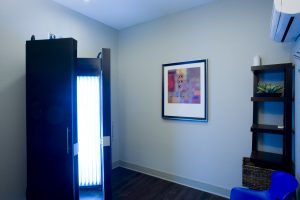 Sunlight provides extensive benefits for our health which result from exposure to its UV rays, visible light, and infrared rays, with each part of the sun’s spectrum having its own physiological effects on the body. The sun is our main source of these different wavelengths of energy, and regular exposure comes with many health benefits. While exposure to the sunshine at any time can provide almost the full spectrum, UVB rays that are needed to make vitamin D are not always readily available. And while the sun is meant to be our main source of vitamin D, most of us do not get the amount of midday sun exposure required to get adequate amounts of vitamin D from the sun. On top of that, during the winter months at latitudes above ∼35°, there is minimal, if any, vitamin D production in the skin from sun exposure.
Sunlight provides extensive benefits for our health which result from exposure to its UV rays, visible light, and infrared rays, with each part of the sun’s spectrum having its own physiological effects on the body. The sun is our main source of these different wavelengths of energy, and regular exposure comes with many health benefits. While exposure to the sunshine at any time can provide almost the full spectrum, UVB rays that are needed to make vitamin D are not always readily available. And while the sun is meant to be our main source of vitamin D, most of us do not get the amount of midday sun exposure required to get adequate amounts of vitamin D from the sun. On top of that, during the winter months at latitudes above ∼35°, there is minimal, if any, vitamin D production in the skin from sun exposure.
What can be done during the winter months, or when going outside at midday, when UVB rays are available, is not an option for you?
Indoor UV Devices Can Provide Differing Aspects of the Sun’s Spectrum
When considering a source of artificial UV light, it is important to be aware of the type of UV or light emitted by the device, its safety, and the physiological effects it may produce, especially in terms of vitamin D. Indoor sun and UVB lamps and bulbs are effective at helping to boost vitamin D production in the skin, however, some of these lamps may only offer UVB and no UVA exposure, so vitamin D may be produced but not nitric oxide, and the full benefits of sunshine may not be achieved without exposure to the sun itself. However, since UVB rays may be the most difficult for some to obtain, using an indoor UVB option in addition to outdoor sunshine may be just the right fit. If outdoor sunshine in any amount is not an option, or if you are unable to get as much exposure to sunlight as you would like, choosing an indoor UV device that produces a wider spectrum of light and energy might be a better choice and could act as your ‘sunshine supplement.’
Can Indoor UV Options Safely Raise Vitamin D Levels?
When it comes to using indoor UV to make vitamin D, it is always a good idea to measure the vitamin D to ensure your target vitamin D level is achieved and maintained. In a previous post, we analyzed data from the GrassrootsHealth cohort to show that participants who did not supplement with vitamin D could reach the recommended level of 40-60 ng/ml (100-150 nmol/L) with the regular use of indoor UVB devices.
A new analysis of GrassrootsHealth participant data shows that those who were not supplementing with vitamin D but indicated using UV equipment in the past 6 months (such as a table top light or sunbeds at a tanning salon) were approximately 70% more likely to have vitamin D levels at or above 40 ng/ml (100 nmol/L) than those who did not use UV equipment or supplement.
This was the first analysis completed after adding new UV device questions to the GrassrootsHealth D*action Lifestyle questionnaire, including if UV equipment had been used in the last 6 months, type of device used, name of the device, how often it was used, and length of time per session. If you would like to contribute your UV and sunshine data to this study, please enroll and order your vitamin D test kit today!
Different Types of Indoor UVB Provide Different Vitamin D Results
A study by Kimball et al. (2017) on sunbeds and vitamin D in Canada found that individuals following standard sunbed tanning protocols in a typical tanning salon can achieve physiological levels of vitamin D when the sunbed emits UVB light in the range equivalent to outdoor summer sunshine, which most sunbed lamps do. More than 75% of all four study groups were considered vitamin D deficient (<30 ng/mL, or <75 nmol/L) at the start of the study, in the wintertime.
As shown in the chart above, vitamin D levels increased by an average of 17 ng/ml (42 nmol/L) in participants using sunbeds that used 100W and 160W fluorescent bulbs with 2.2% and 4.2% UVB. Vitamin D levels continued to increase after a base tan was achieved, all the way to the end of the 12-week study, with no adverse events or skin burns reported. This study supports the use of artificially derived UVB light to raise serum vitamin D levels when the UV index of the sun is low, especially in the winter months of northern countries. Keep in mind, as touched on in this short video, that tanning beds may not be recommended for individuals with skin types that always burn.
In another study published to address the use of indoor UV sources to produce vitamin D, Dr. Michael Holick concluded that exposure to lamps that produce UVB radiation are an excellent source for producing vitamin D3 in the skin. For this study, fifteen healthy adult participants were exposed to 0.75 minimal erythemal dose (MED) three times a week. One MED of UVB, the amount of UV radiation that will produce minimal redness or sunburn, is roughly equivalent to ingesting between 10,000 and 25,000 IU of oral vitamin D.
Using the Fitzpatrick classification of skin phototype, Dr. Holick found that healthy adults with skin type 2 (fair, burns easily) and skin type 3 (darker white skin, tans after initial burn) experienced dramatic improvement in vitamin D status after exposure to UVB radiation in a commercial tanning bed. After 1 week, vitamin D levels had risen by 50% and continued to rise over 5 weeks to approximately 150%. After 5 weeks, vitamin D levels plateaued and were sustained until week 7.
Indoor UV Devices: Demonstrated through History and Proven through Research
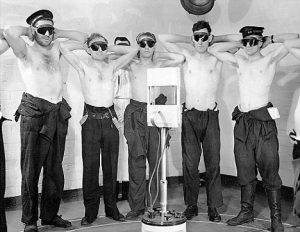 What indoor UV methods have been implemented historically to combat vitamin D deficiency diseases and ensure healthy levels of vitamin D year-round, and should these methods be re-implemented today? In the recorded lecture titled Sunlight and Your Health: An EnLIGHTening Perspective, shared earlier this sunshine month, Dr. Michael Holick explains how history demonstrates that natural as well as artificial sunlight can act as a major interventional tool to help prevent and heal devastating diseases. In fact, before antibiotics, the medical community embraced phototherapy as the state-of-the-art treatment for a variety of ills. Phototherapy is still used to today to treat conditions such as eczema, psoriasis, jaundice, mood and sleep disorders, and some cancers – and vitamin D deficiency.
What indoor UV methods have been implemented historically to combat vitamin D deficiency diseases and ensure healthy levels of vitamin D year-round, and should these methods be re-implemented today? In the recorded lecture titled Sunlight and Your Health: An EnLIGHTening Perspective, shared earlier this sunshine month, Dr. Michael Holick explains how history demonstrates that natural as well as artificial sunlight can act as a major interventional tool to help prevent and heal devastating diseases. In fact, before antibiotics, the medical community embraced phototherapy as the state-of-the-art treatment for a variety of ills. Phototherapy is still used to today to treat conditions such as eczema, psoriasis, jaundice, mood and sleep disorders, and some cancers – and vitamin D deficiency.
Guidelines for Safe Use of Sunbeds from Health Canada
If considering using indoor tanning options, such as sunbeds, do your research and be sure to follow safety guidelines, such as those set by Health Canada.
- Look for, read, and follow the warning and technical labels on the equipment. Labels tell you the recommended time you should be exposed each session (the time will vary, in part, depending on your skin type).
- Talk to the salon operator about your skin’s sensitivity and your ability to tan.
- Do not go over the recommended time in a tanning session for your skin type.
- Do not use tanning lamps more often than is prescribed for your particular skin type.
- Always wear the safety eyewear that is recommended for the type of lamp you are using.
- Allow at least 48 hours between each tanning session. This will give your skin a chance to repair some of the damage from the UV rays and may slow down the aging effects caused by the exposure.
- Report any side effects (like sunburn or itchiness) to the salon operator. In cases of severe sunburn, see your health care provider.
Be aware that certain medications and products may increase the sensitivity of the skin to UV exposure, such as some antidepressants, antibiotics, antihistamines, psoralens, antifungals, antidiabetic, oral contraceptives, tranquilizers, high blood pressure medications, and certain soaps or cosmetics. For a full list of medications and products, click here.
Practicing safe sun exposure is a natural way to increase your vitamin D levels. As reviewed above, studies have shown that you can also reach recommended vitamin D levels (>40 ng/ml or >100 nmol/L) using indoor UVB options and following time exposure guidelines for your skin type without adverse events. In fact, these options to raise vitamin D levels may even be preferred among individuals who may not respond as well to supplementation, such as those with digestive conditions or on certain medications that may inhibit absorption.
